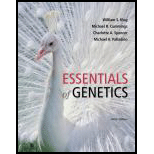
Concept explainers
What is VNTR profiling, and what are the applications of this technique?
To review:
VNTR (Variable number tandem repeat) profiling and its applications.
Introduction:
All cells of an organism have genetic material mostly in the form of DNA (deoxyribonucleic acid). The basic chemical structure of the DNA molecule between different species of organisms remains the same but the sequence of the nitrogenous bases differs. On the other hand, in individuals of the same species, the basic sequence remains conserved, only some repeat sequences in the DNA molecules differ in length depending upon how many times the particular sequence is tandemly repeated.
Explanation of Solution
VNTR is a specific genome location, where there are tandem repeats of short nucleotide sequences (10-100 base pairs long). These tandem repeats vary in length amongst different individuals. These VNTR sequences are inherited by the offspring from their parents as they are parts of the DNA sequences.
DNA typing or DNA profiling is a technique that distinguishes between the individuals belonging to the same species using DNA samples from blood, hair, or other tissues. The DNA sequences, if checked for VNTR sequences then it is known as VNTR profiling.
The VNTR sequences differ in length in different individuals and are flanked by restriction endonuclease sites. Upon action of the restriction enzymes on these sequences, different DNA segments are yielded, which in turn give different RFLP (restriction fragment length polymorphism) patterns.
A VNTR profile is created by first digesting the VNTR repeat region on the DNA with the help of restriction enzymes, separating the cleaved VNTR segments using gel electrophoresis, followed by Southern blotting. The DNA segments blotted on the membrane are thus hybridized with a probe for identification. These DNA segments can, therefore, be used for forensic studies to find missing people, to determine the parent of a child, and to establish whether a person is a criminal or not.
Thus, it can be concluded that VNTR profiling is a technique of DNA typing, which utilizes VNTR segments to distinguish between individuals of the same species. This technique is involved in forensic studies to determine a child’s parents, in determining criminals, and also to find missing people.
Want to see more full solutions like this?
Chapter CHST3 Solutions
Essentials of Genetics (9th Edition) - Standalone book
- Explain in a small summary how: What genetic information can be obtained from a Punnet square? What genetic information cannot be determined from a Punnet square? Why might a Punnet Square be beneficial to understanding genetics/inheritance?arrow_forwardIn a small summary write down:arrow_forwardNot part of a graded assignment, from a past midtermarrow_forward
- Noggin mutation: The mouse, one of the phenotypic consequences of Noggin mutationis mispatterning of the spinal cord, in the posterior region of the mouse embryo, suchthat in the hindlimb region the more ventral fates are lost, and the dorsal Pax3 domain isexpanded. (this experiment is not in the lectures).a. Hypothesis for why: What would be your hypothesis for why the ventral fatesare lost and dorsal fates expanded? Include in your answer the words notochord,BMP, SHH and either (or both of) surface ectoderm or lateral plate mesodermarrow_forwardNot part of a graded assignment, from a past midtermarrow_forwardNot part of a graded assignment, from a past midtermarrow_forward
- Surgical Tech For Surgical Tech Pos CareHealth & NutritionISBN:9781337648868Author:AssociationPublisher:Cengage
 Principles Of Radiographic Imaging: An Art And A ...Health & NutritionISBN:9781337711067Author:Richard R. Carlton, Arlene M. Adler, Vesna BalacPublisher:Cengage Learning
Principles Of Radiographic Imaging: An Art And A ...Health & NutritionISBN:9781337711067Author:Richard R. Carlton, Arlene M. Adler, Vesna BalacPublisher:Cengage Learning  Human Heredity: Principles and Issues (MindTap Co...BiologyISBN:9781305251052Author:Michael CummingsPublisher:Cengage Learning
Human Heredity: Principles and Issues (MindTap Co...BiologyISBN:9781305251052Author:Michael CummingsPublisher:Cengage Learning





